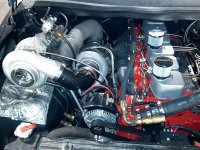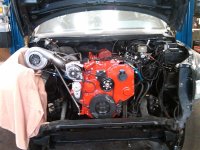I don't doubt he is a good dude, but the way he presesnts himself through his smart@ss posts doesn't do much for him.
This turned into a major :soap:
Although, I still feel there is much to be discussed in the theory of compounding turbo's.
If i get permission to post another memebers personal opinion on compounding chargers, I will start a new thread.......
Kyle
I don't know what the deal is...
But I just
can't act right when I have to type everything out. It's cold, stale text. It's about worthless for communication. No
real tone, no voice inflection to show the
true direction of a comment, whether humorous or serious, so on and so forth.
And truth be told, I think I'm always in a constant state of frustration because of that, independent of whatever I'm actually talking (typing) about. And yet I'm drawn to it like a moth to a flame because where else are you going to find this many people to talk about something like this?
Anyway..... I was a dick online. Unfortunately it's not something I seem capable of fixing at present. Maybe with age will come wisdome... lol.
As far as tuning a set of compounds goes. All I can offer is my own experience with my smallish setup.
I have a drop in charger for my second stage, which may skew my findings. It's a GTP38R drop in replacement with a 1.15 housing. My first stage is a GT4718 journal bearing unit with a 1.39 housing.
For me... and the testing I have done (which over the years has been pretty in depth) the best boost/drive ratio and power has come when the chargers were very closed to being balanced, meaning each was contributing a similar amount to the overall pressure ratio. Most of my testing has been between 60 and 80lbs of boost, although I have driven them as high as 90+ a number of times as well. However, I think the stuff in the 60-70psi range is most relevant for a street truck, and that's what I run 99.9% of the time anyway.
In that range of boost pressures, I have driven the first stage anywhere from 10psi to 35+psi at WOT while maintaining overall boost by altering the second stage output accordingly. Having had electronic boost control solenoids driving both gate ports on both gates it was fairly easy for me to settle in on just about any desired boost, and any desired first to second stage split from the comfort of the driver's seat with the laptop. I also datalogged exhaust manifold drive pressure, first stage boost pressure and intake manifold pressure a good bit while trying to get the most from the setup.
What I found (on my truck) was actually shocking to me. With a 1.39 A/R housing on that 88mm first stage charger I always expected it to basically be a straight shot, and that the second stage turbine housing/wastegate would certainly be producing the brunt of the drive pressure. However, as I drove the first stage higher and higher (while holding manifold pressure constant by opening the second stage gate more and more) the overall drive pressure and subsequently the overall boost/drive ratio just got worse and worse and worse. At 70lbs of boost I was running drive pressures of nearly 90psi. A boost/drive ratio of ~1.3:1. I was shocked. So I started backing it back down and the boost/drive kept getting better and better as you would expect, until I started going under ~20lbs on the first stage. Then it started getting worse again. When running 20 -25psi on the first with a manifold pressure of 60 - 65psi I was consistently running a drive pressure of 55 to 60psi. Meaning my boost/drive was right at, or slightly less than 1:1.
Coincidentally, the truck smoked less and pulled harder up top when configured this way. The only thing I didn't do was run the ratio up and down like this while on the dyno. Which I'm sure I will at some point. Probably the same day I start testing various water injection pressures and such, if that day ever comes, lol.
But anyway, that's my experience with it, and my reasoning is that the highest efficiency comes when the chargers are sharing the load well.



